
A number of mature trees are reportedly being removed in the Choa Chu Kang estate. STOMPer Alan suspects that the removal may be unauthorised.
The STOMPer said:
"It seems like someone is illegally removing mature trees in the Choa Chu Kang estate.
"This tree was totally removed after today."
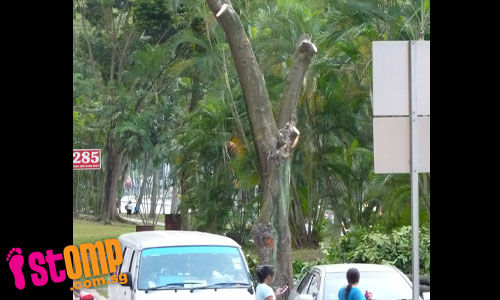
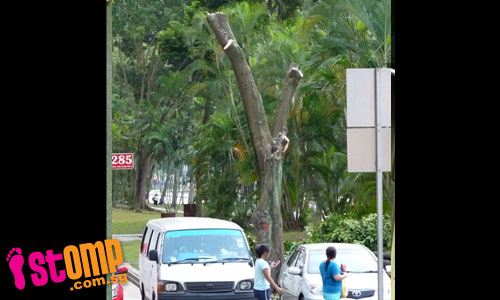
These are some very serious allegations, and unfortunately, the person who submitted this did not provide more details that could help strengthen the suggestion that this removal of trees was taking place illegally.
The Parks and Trees Act provides some form of protection for trees growing in nature conservation areas and other places, such as those designated as tree conservation areas or heritage road green buffers.
However, people who seek to protect some individual trees from being felled often have to contend with others who argue that fallen leaves clog up drains and collect rainwater, providing breeding grounds for mosquitoes, or the potential risk to human lives and property due to branches or even entire trees falling during storms or due to disease. Then there are those instances where it is decided that trees simply have to make way for development.
Recent examples include an angsana (Pterocarpus indicus) on Braddell Road, which was initially spared the chainsaw when construction of the Braddell-Lornie flyover began in 2005. At first, it was hailed as an example of how development did not always have to clash with nature. However, despite precautionary measures such as additional road markings and safety signs, many motorists who ignored the speed limits ran the risk of collisions. And as a result, the decision was finally made to remove the tree after all. There were many voices on both sides, although the majority seemed to prefer keeping the tree around. In July 2007, the Braddell angsana was felled, triggering letters from members of the public who wrote on behalf of the tree.
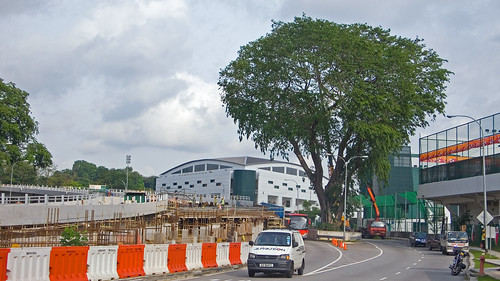
The Braddell angsana on the day of its removal;
(Photo by acroamatic)
Another example occurred during the same period of time, that of a large bodhi or sacred fig (Ficus religiosa) growing on the site of the Jin Long Si Temple off Bartley Road. The land was supposed to be acquired for residential use, part of the development of the surrounding areas in conjunction with construction of the Circle Line. Despite attention from the public, a petition that apparently garnered 5,000 signatures, and a spurt in letters to the press to appealing for the bodhi tree to be spared after the Braddell angsana was chopped down, a lawsuit that had been filed for the temple to remain at its original site was dismissed, but with the caveat that the bodhi tree would be saved.

The bodhi tree at Jin Long Si Temple;
(Photo by Ali Kati)
A somewhat more dramatic case in 2008 involved a mango tree (Mangifera indica), which became the centre of a conflict between a shopowner and the management committee of an estate in Simpang Bedok. Ardent local conservationist Joseph Lai became involved as well, inspecting the tree and declaring it healthy, as well as helping to spread the word. The clash carried on for nearly 2 months, and despite the best efforts of some to keep the chainsaws away, the mango tree was finally felled.
But these incidents pale in comparison to what is seen as a tragedy and outrage in nature conservation circles: the felling of the chengal pasir (Hopea sangal) in Changi. Formerly thought to be extinct in Singapore, the rediscovery of this particular tree in 2002 was hailed as a momentous find. Not only because the species was not completely extinct here, but its location had a particular significance, since the name Changi might have been inspired by the local name for this tree.

The Hopea sangal tree at Changi;
(Photo by Tan Beng Chiak)
Tragically, in November of that same year, the tree was illegally felled, and Sivasothi, who had wanted to take a look at the tree, arrived just in time to witness the aftermath. The media picked up the story, and Joseph Lai, who had helped initiate the census that led to the rediscovery of the Hopea sangal, penned an ode to the magnificent tree. Even though the company responsible was subsequently ordered to pay the state $76,035 in compensation for the loss of the tree and fined $8,000 for chopping down a tree in a gazetted tree conservation area without prior approval from the authorities, the damage had already been done.




The end of the Hopea sangal in Changi;
(Photos by Sivasothi)
A burning question that remained was what to do with the logs, which had been recovered from a timber yard. Eventually, a sculpture symposium was held, allowing the logs to be turned into works of art. The 9 sculptures which were created were adopted and exhibited at the Singapore Zoo, where they stand in front of its main entrance.
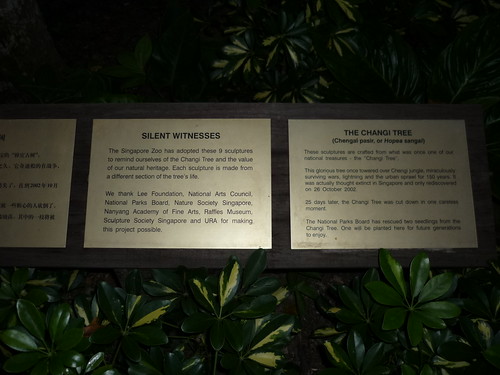
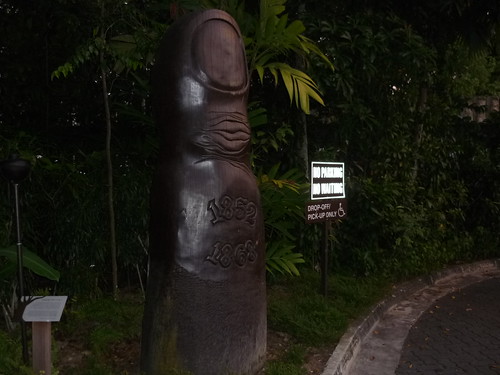
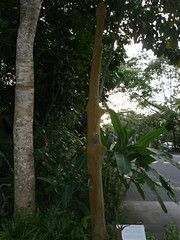
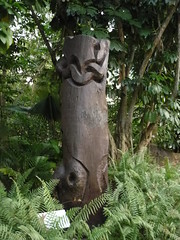
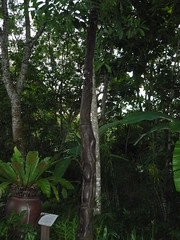
A selection of the sculptures made from the Hopea sangal tree;
Two slices of the trunk were presented to the Raffles Museum of Biodiversity Research for display and education. They were subsequently cured and varnished, with one slice now being exhibited at the Changi Museum.
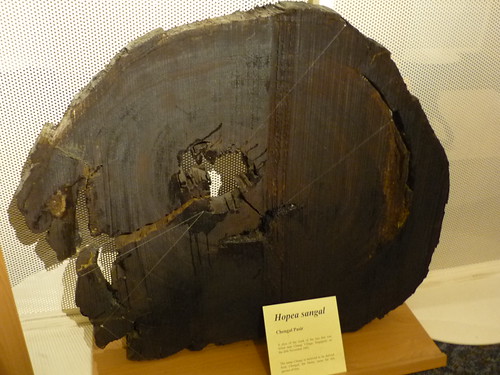
Slice of Hopea sangal trunk exhibited at the Public Gallery of the Raffles Museum of Biodiversity Research;
As consolation, seedlings had been grown from seeds collected before the tree had been felled, and were grown in nurseries. Some of the saplings have since been planted in various parts of Singapore; for instance, former Minister Mentor Lee Kuan Yew planted one such sapling in Henderson.
Another sapling was planted at the Singapore Zoo, and it stands opposite the sculptures created from the wood of its parent.
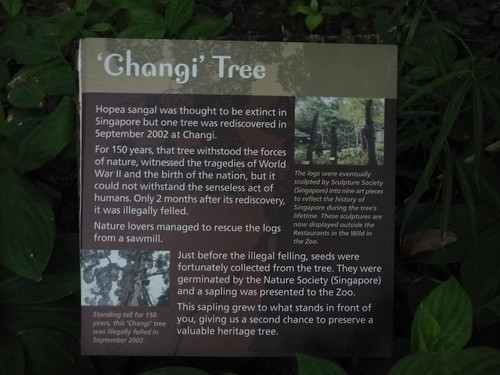
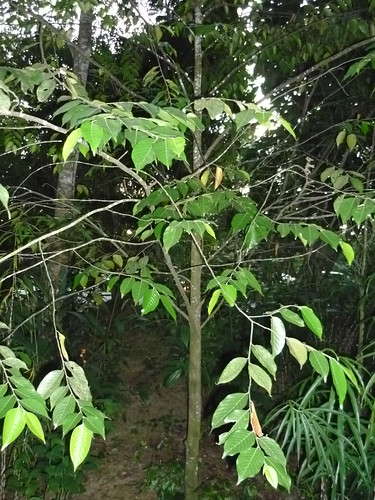
Thirty saplings have also been planted at Kent Ridge Park.
You can view an entire timeline of the saga of the Hopea sangal from 2001 to 2006.
We are easily awed by the majesty and grandeur of mature trees, marvelling at their great height or girth, or their distinctive features. Since trees don't move, it is easy to track the progress or decline of individual trees over time, and we soon come to look upon some as old familiar friends; for instance, my visits to Chek Jawa would not be complete without at least gazing upon the pulai (Alstonia angustiloba) that stretches above the canopy, or the apparently dead perepat (Sonneratia alba) that has remained standing on the mudflat all these years.
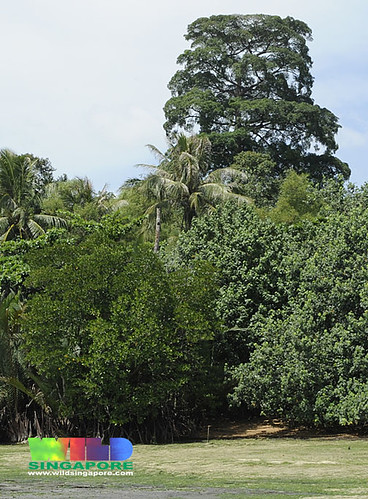
The pulai of Chek Jawa;
(Photo by Ria)

The iconic dead perepat of Chek Jawa;
(Photo by beggs)
Another famous tree of Singapore would be the tembusu (Fagraea fagrans) that grows in the Singapore Botanic Gardens, and is featured on our $5 note.

(Photo by Purple_man)
Who knows what other tree-inspired stories are waiting to be told?